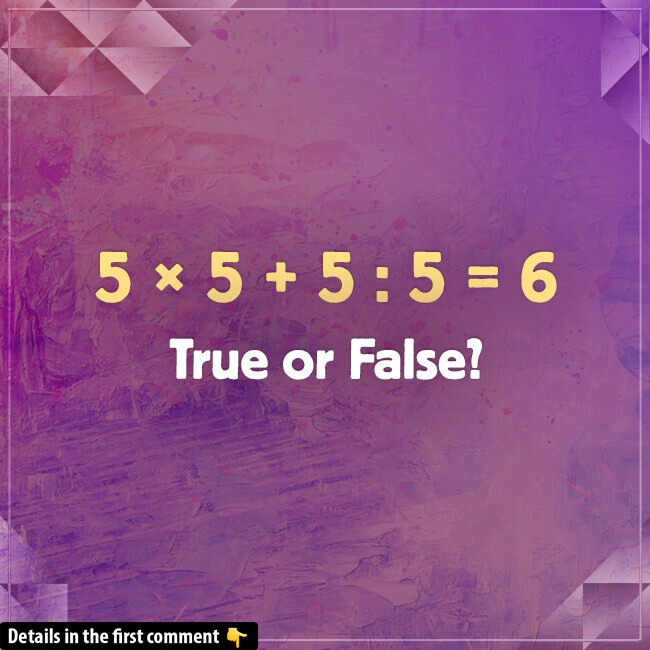Some math problems are straightforward. Others? They’re cleverly designed traps waiting to expose your blind spots. The equation 5 × 5 + 5 ÷ 5 falls squarely into the second category. At first glance, it looks simple—something you could solve in your head in seconds. But slow down. This problem isn’t just about math. It’s about logic, rules, and the discipline to apply them.
So, can math trick you? Absolutely—if you let it.

The Problem That Trips Up So Many
Let’s take a closer look at the puzzle:
5 × 5 + 5 ÷ 5 = ?
You may think:
“Easy! Multiply, add, divide—done!”
But that’s where the trap begins.
A surprising number of people will shout out “5 × 5 = 25, plus 5 is 30, divided by 5 is 6!”
Sounds good?
It’s wrong.
That mistake happens because we often ignore the most important rule in solving math expressions: order of operations.
Video: Pause and give your mind a refresh with these playful puzzles!
Why PEMDAS Is the Key to Solving It Right
Let’s bring in the superhero of math rules: PEMDAS.
If you grew up with math textbooks in hand, you probably remember this acronym. It stands for:
- P – Parentheses
- E – Exponents
- MD – Multiplication and Division (from left to right)
- AS – Addition and Subtraction (from left to right)
This rule is not just some teacher’s favorite buzzword—it’s the law that guides how expressions must be solved. Ignore it, and your answer is almost guaranteed to be wrong.
Breaking It Down Step-by-Step: Follow the Logic
Let’s solve 5 × 5 + 5 ÷ 5 the right way.
Step 1: Handle the Multiplication
- 5 × 5 = 25
Step 2: Handle the Division
- 5 ÷ 5 = 1
Step 3: Now Add the Results
- 25 + 1 = 26
That’s it. The correct answer is 26.

Why Do So Many People Get This Wrong?
Let’s be real—math isn’t hard because numbers are scary. It’s hard because our brains love shortcuts. We see a string of numbers and symbols, and our mind instinctively moves left to right, skipping any proper structure. It’s like reading a sentence backwards—you get the gist, but not the truth.
Here are some common traps people fall into:
- Skipping steps: People jump straight from multiplication to addition and then casually divide the final result.
- Left-to-right thinking: Math doesn’t always work like reading. You have to prioritize operations.
- Second-guessing yourself: Overthinking leads people to suspect there’s a trick when really it’s just about rules.
Math Isn’t Magic—It’s Just Method
This puzzle isn’t about catching you off guard. It’s about discipline. It asks, “Are you paying attention?” Like a well-disguised riddle, it’s testing whether you stick to the system or let your instincts override logic.
And honestly, that’s the fun part of math. It rewards clarity over chaos. It’s like solving a crime scene where the clues are out in the open—you just need to read them in the right order.
How Puzzles Like These Sharpen Your Thinking
Video: Can Math Trick You?
Solving puzzles like this isn’t just about math—it’s brain training. Every time you step through a process like PEMDAS, you’re reinforcing your ability to think critically, make decisions under pressure, and stay focused.
In a world full of noise and distractions, being able to slow down and follow a method is a superpower.
You might not need PEMDAS every day, but the mindset it teaches you? That’s priceless.
Let’s See What You’ve Got—Share Your Take!
Now that you know the correct breakdown, we want to hear from you.
Did you get 26 right on the first try? Or did you fall into one of the common traps?
Take a moment to write out your own explanation. Walk through it step-by-step and compare notes with others. There’s a lot to learn from different approaches—even the wrong ones.
Sharing how you think helps others sharpen their own logic. And hey, it’s a lot more fun to learn together.
Puzzles That Play With Perception Keep Us Sharp
What makes this problem special isn’t its difficulty—it’s its ability to mislead. It’s a clever little reminder that sometimes, the simplest-looking problems are the ones that require the most attention.
And that’s the beauty of it.
These puzzles teach us to look again. To question what we think we know. To apply what we’ve learned, not just guess.
Conclusion: Trust the Process, Not the Panic

So, can math trick you? Yes. But only if you let it.
The equation 5 × 5 + 5 ÷ 5 is a perfect example of how easily our minds can misfire when we ignore the rules. The answer isn’t a mystery. It’s just a reminder that logic beats instinct when it comes to problem-solving.
Whether you’re a puzzle fanatic or someone brushing up on the basics, let this be your takeaway:
In math, method is everything.
Stick to it, and you’ll never be fooled again.


